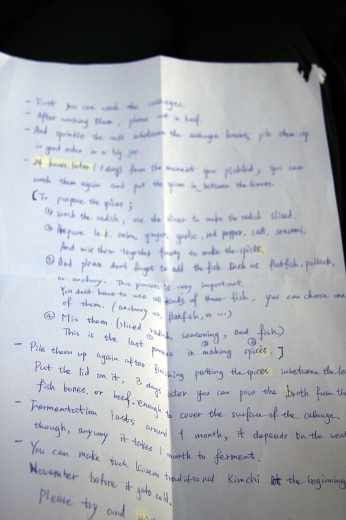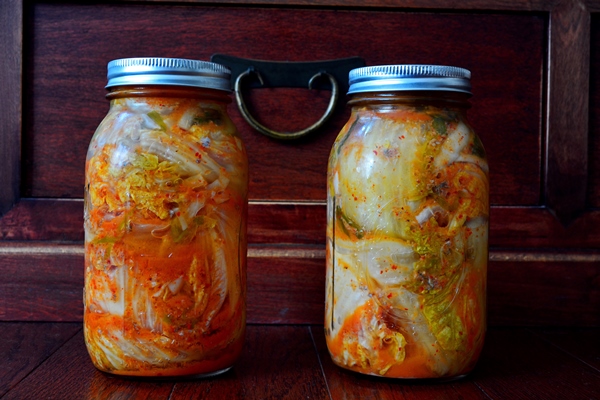
According to Michael, communist, North Korean kimchi is, in general, less salty, less spicy, waterier and fishier than the democratic kimchi in South Korea. Internet searches simply confirmed Michael’s observations, so his words were all I had to go on. My read of the North Korean recipe was that it had three major differences from South Korean recipes. The first difference was a long time – 24 hours – for salting/brining that preceded the seasoning of the cabbage. The second one was that fishy flavor, and the third was that after three days of fermenting, the jars were opened and topped with beef or fish broth and then re-sealed.
Now, my South Korean kimchi recipe, usually packs a bit of a wallop of spice, but has only a couple of tablespoons of salted shrimp or anchovies in it. The fish makes it a bit more savory, and helps to balance the red pepper and ginger, but it doesn’t impart a “fishy” flavor, so that was the first challenge. The second challenge was the 24-hour salting/brining that the North Korean recipe calls for. That seemed like a long time to brine cabbage, I usually only brine for about 3 hours maximum. Some South Korean recipes don’t brine the cabbage at all. I wondered just how much of the vegetable I would have left after 24 hours. Expecting to over fulfill the plan, I bought a lot of sprats. I chose sprats because they are small and cheap, and I could get them fresh.
For the first iteration of the recipe, I kept the ingredients the same as my S. Korean kimchi and used the North Korean salting procedure along with about 3/4 of a pound of fresh, cleaned sprats. This was good, not too fishy, and very spicy. I thought that if I decreased the spiciness and saltiness, the fish flavor would shine through more. So, I tried again. The second iteration of the recipe looks like this:
DPRK Kimchi – 2nd Iteration
Ingredients
2 Napa Cabbages, washed and cut in half (four halves)
1/2 cup coarse sea salt, divided into four 1/8 cup batches
Kimchi Seasoning
1 bunch of spring onions (6-8 onions)
1 leek
2-3 cups Korean radish, peeled and matchsticked (not daikon)
¾ -1 cup medium to large garlic cloves, peeled
1 piece of ginger – 4-5 inches by 1.5 inches
1/3 cup coarse red pepper powder (Gochu) (generously measured – i.e. “heaping”)
2-4 tablespoons coarse sea salt, or to taste
4-8 tablespoons sugar, or to taste
3/4 pound fresh sprats
Beef-flavored Dashida to taste
I tasted it about 10 days after adding the broth on day three of the refrigerated ferment. This recipe yields a savory, umami, gingery kimchi that is delicious, but not particularly fishy. Based on Michael’s description, I thought that it would still be too flavorful to be anything like North Korean kimchi, so I went back to the drawing board to try again.
DPRK Kimchi – 3rd Iteration
Ingredients
2 Napa Cabbages, washed and cut in half (four halves)
1/3 cup coarse sea salt, divided into four batches
Kimchi Seasoning
1/2 bunch of spring onions (4-6 onions)
1 leek
2-3 cups Korean radish, peeled and matchsticked (not daikon)
1/2 cup medium to large garlic cloves, peeled
1 piece of ginger – 3-4 inches by 1.5 inches
1/4 cup coarse red pepper powder (Gochugaru) (generously measured – i.e. “heaping”)
1-2 tablespoons coarse sea salt, or to taste
2-4 tablespoons sugar, or to taste
3/4 pound fresh sprats
Anchovy-flavored Dashida or Japanese Hon-Dashi to taste
Directions
Cabbages were washed and drained. Then the leaves were salted. All four halves were placed in a covered container with no water. The next morning a significant amount of water had accumulated. The cabbage halves were shifted several times to allow those pieces on top some time in the brine. Cabbages were brined for approximately 24 hours.
When the brining is completed, the cabbage should be pliable as if it had been parboiled. Place cabbages in a colander and let drain. The, one-by-one, immerse the cabbages in a vessel filled with fresh water. Turn faucet on and allow water to run into vessel as you work the water around the leaves for a minute or two. When done, place cabbages in a colander and let drain. Do a second rinse and let cabbages drain as seasoning is prepared.
Trim the roots from the onions and leeks and remove any damaged greens. Wash both vegetables very well – especially the leeks. Trim onions into 3-4 inch segments, then cut in half lengthwise. Separate the leek greens from the base and quarter the base. Then trim the base segments into 3-4 inch strips and slice lengthwise. Trim the leek greens in a similar manner. Add match-sticked radish to the vegetable mix.
Peel the ginger, roughly chopped and place in the food processor along with the garlic cloves. Pulse these until very fine, but not quite a paste has formed. Add to the vegetable mix along with the gochugaru, sea salt and sugar and mix well.
Then clean the sprats. Rinse and pulse in the food processor until very fine. Add the ground sprats to the vegetables and seasonings and mix well. Cover and set aside for at least ½ hour.
After ½ hour, stir the seasoning mix. You could coat the cabbages with it, or let it sit for more time and become juicier. I usually let mine sit for an hour or two, stirring every half hour, before moving on to the next step. When ready to season, take up the halved cabbages, one-by-one and slide the seasoning between each row of cabbage leaves, coating the leaves evenly with the spices. When the cabbage coating is done, slide them into jars, placing an extra bit of the seasoning mix in the jars as well – no more than 1 or two tablespoons. You can cut the cabbages into smaller bundles if desired as well. Pack the jars more lightly than when making South Korean kimchi to allow for the addition of broth in three days time.
Rest the jars overnight at room temperature to get the fermentation going, then refrigerate to slow fermentation.
At day three, remove the jars from the fridge and allow them to rise towards room temperature. Make Dashida broth or Hon Dashi according to taste or use about 2 teaspoons of dehydrated stock to 2.5-3 cups of water. When the kimchi AND the broth are at or near room temperature, open the jars in the sink and allow them to bubble up. If necessary, remove some kimchi from the jars to leave about 1.5 – 2 inches of space at the top of the jar. Pour the broth into the jar and insert a spoon to make sure the broth penetrates to the center and bottom of the jar. Repeat another time or two, top off the broth and seal the jars. Wash and dry the jars and place back in the refrigerator at the earliest time possible. Wait 3 days to 1 week and North Korean kimchi is served.
_____

As you can see the North Korean kimchi samples are much lighter in color than South Korean kimchi – owing to the much lower amount of red-pepper and possibly of salt in the Northern recipes. Interestingly, I found that between 3/4 pound and 1 pound of sprats did not produce a fishy flavor. All this fish just made the kimchi savorier and added a bit of an umami factor – especially to the 2nd iteration sample. The fishy flavor, came from the addition of the fish broth after a few days of fermentation.
When all was said and done, Michael held a Kimchi Smackdown in New York City to compare the taste of my North Korean kimchi samples with a family South Korean recipe and some store bought kimchi from Koreatown. You’ll have to go to Michael’s write up of the Smackdown to see which kimchi won, but I will tell you that the “3rd Iteration” recipe above was the closest to the kimchi Michael ate over in North Korea.
Most of the tasters did NOT like the limp texture of the North Korean kimchis, but you can correct for this by salting or brining for less time than 24 hours. Try, say 3-4 hours instead and your kimchi will be much more crisp and crunchy. I like the 2nd iteration sample over the third and may even make it instead of my usual S. Korean recipe from time to time.
This was a fantastic experience which I enjoyed immensely – and would do again in a heartbeat. It is wonderful to learn about another culture through their cuisine, and this was particularly interesting because of the lack of information about foods of the North.
In closing, I’d like to remind everyone that kimchi of any sort is extraordinarily good for you as well. It is packed full of probiotic organisms, such as Lactobacillus species as well as millions of bacteriophage to get the gut going and keep them going. A great deal of our front-line immune defenses are also in the gut, so a diverse population of microorganisms down there make for a stronger immune response (at least in part).
(Words and recipe development by Laura Kelley. Photo of Handwritten North Korean Kimchi Recipe by Michael Y. Park; Photo of North Korean Kimchi 2nd and 3rd Iteration by Laura Kelley. Thanks to Michael Y. Park for sending me the recipe and allowing me to take part in his Kimchi Smackdown, and thanks to Elliot, Seungah for hosting the Smackdown and Rahul for lending his tastebuds to the task. Special thanks to Ms. Kim Nesbit for her assistance and advice during recipe development.)
